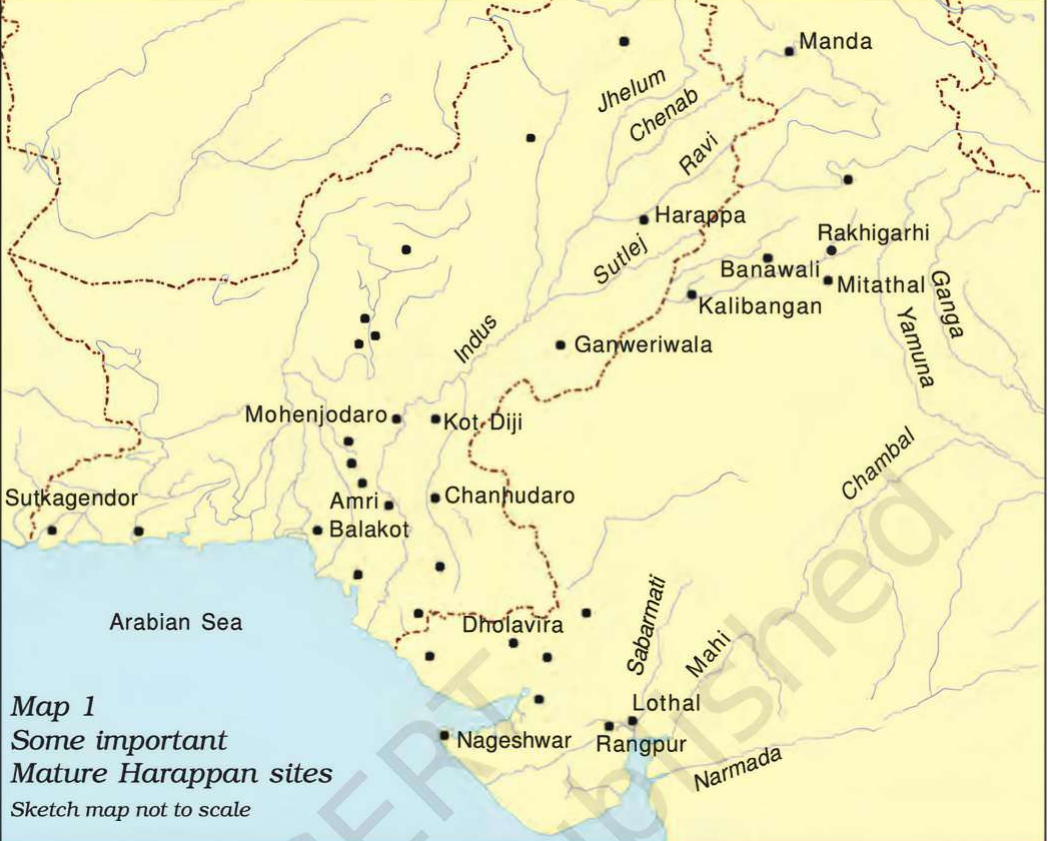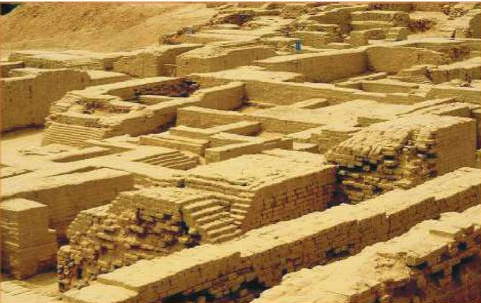Ancient History Playlist
11 chapters • 0 completed
Stone age
5 topics
Chalcolithic age(Copper Age)
2 topics
Indus Valley Civilization
5 topics
Vedic age
15 topics
The Mahajanapadas
8 topics
Buddhism and Jainism
16 topics
Mauryan Empire
11 topics
Post-Mauryan Period
14 topics
Gupta Period
16 topics
Post-Gupta Period
16 topics
Sangam Age
7 topics
Chapter 3: Indus Valley Civilization
Chapter TestIndus Valley Civilization: Background and Origin
The Indus Valley Civilization (IVC), also called the Harappan Civilization, was one of the world’s earliest urban civilizations (c. 2500–1750 BCE). It flourished in the northwestern regions of the Indian subcontinent, known for advanced city planning, trade, and craft specialization.
The Indus Valley Civilization (IVC), also called the Harappan Civilization, was one of the world’s earliest urban civilizations (c. 2500–1750 BCE). It flourished in the northwestern regions of the Indian subcontinent, known for advanced city planning, trade, and craft specialization.

Phases of Indus Valley Civilization
| Phase | Time Period | Features |
|---|---|---|
| Early Harappan (Pre-Harappan) | 3300–2600 BCE | Village settlements, pottery, trade beginnings |
| Mature Harappan | 2600–1900 BCE | Planned cities, script, seals, drainage, trade |
| Late Harappan (Decline) | 1900–1500 BCE | De-urbanization, rural settlements, cultural decline |
Fun Facts
The Harappans were the first to cultivate cotton, which the Greeks later called 'Sindon'.
Mohenjo-daro’s Great Bath is one of the earliest public water tanks in the world.
No temples have been found, suggesting a unique religious system compared to other Bronze Age cultures.
The standard weights and measures of Harappans indicate a highly regulated trade system.
Mains Key Points
Prelims Strategy Tips
Important Indus Valley Civilization Sites
The Indus Valley Civilization had over 1,000 sites spread across modern India, Pakistan, and Afghanistan. Each major site has distinctive features that reveal the diversity and advancement of Harappan culture.
The Indus Valley Civilization had over 1,000 sites spread across modern India, Pakistan, and Afghanistan. Each major site has distinctive features that reveal the diversity and advancement of Harappan culture.
Major Indus Valley Sites and Key Features
| Site | Region | Unique Features |
|---|---|---|
| Harappa | Punjab (Pakistan) | Granaries, seals, Cemetery R-37 |
| Mohenjo-daro | Sindh (Pakistan) | Great Bath, Dancing Girl, Bearded Priest |
| Lothal | Gujarat (India) | Dockyard, rice remains, bead-making, fire altars |
| Kalibangan | Rajasthan (India) | Ploughed fields, fire altars |
| Dholavira | Gujarat (India) | Water reservoirs, long signboard inscription |
| Rakhigarhi | Haryana (India) | Largest Harappan site in India, burials |
| Banawali | Haryana (India) | Pre-Harappan + Harappan phases, toy carts |
| Mehrgarh | Baluchistan (Pakistan) | Pre-Harappan Neolithic-Chalcolithic, early farming |
| Surkotada | Gujarat (India) | Horse bones, fortified settlement |
| Ropar | Punjab (India) | Burial with dog and human skeletons |
| Chanhudaro | Sindh (Pakistan) | Bead-making, shell and ivory work, no citadel |
| Balathal | Rajasthan (India) | Fortified settlement, copper tools |
| Alamgirpur | Uttar Pradesh (India) | Easternmost Harappan site, evidence of pottery |
| Kot Diji | Sindh (Pakistan) | Pre-Harappan fortification, wheel-made pottery |
| Amri | Sindh (Pakistan) | Pre-Harappan culture, pottery |
| Sutkagendor | Baluchistan (Pakistan) | Coastal trade port near Persian Gulf |
| Sutkakoh | Baluchistan (Pakistan) | Harappan trade with Mesopotamia |
| Shortugai | Afghanistan | Trading outpost, lapis lazuli mines |
Prelims Strategy Tips
Indus Valley Civilization: Civic and Political Features
The Indus Valley Civilization (2600–1900 BCE) was remarkable for its advanced civic planning, drainage, fortified towns, and a unique political system without evidence of kingship or palaces.
The Indus Valley Civilization (2600–1900 BCE) was remarkable for its advanced civic planning, drainage, fortified towns, and a unique political system without evidence of kingship or palaces.
Civic and Political Features of IVC
| Feature | Description |
|---|---|
| Street Planning | Grid pattern, wide main roads, narrow lanes, right-angle intersections |
| Drainage | Covered brick drains, soak-pits, house-to-street connections, inspection holes |
| Fortification | Citadel with granaries, baths, defensive walls, flood control |
| Political Structure | No kings/palaces, collective governance, seals for regulation |
Prelims Strategy Tips
Indus Valley Civilization: Art, Economy and Trade
The Indus Valley Civilization was known for its vibrant art in terracotta, bronze, seals, and pottery. Its economy was primarily based on agriculture, craft specialization, and extensive trade networks with Mesopotamia and Central Asia.
The Indus Valley Civilization was known for its vibrant art in terracotta, bronze, seals, and pottery. Its economy was primarily based on agriculture, craft specialization, and extensive trade networks with Mesopotamia and Central Asia.
IVC Art, Economy and Trade
| Aspect | Key Features |
|---|---|
| Art | Terracotta figurines, bronze Dancing Girl, seals, jewellery, painted pottery |
| Economy | Agriculture (wheat, barley, rice), domestication, cotton weaving, handicrafts |
| Trade | Internal (bullock carts, seals), External (Mesopotamia, Oman), Lothal dockyard |
Prelims Strategy Tips
Decline of the Indus Valley Civilization
The decline of the Indus Valley Civilization (c. 1900–1500 BCE) was not sudden but gradual and varied across regions. It was caused by ecological, economic, and social factors rather than a single invasion.
The decline of the Indus Valley Civilization (c. 1900–1500 BCE) was not sudden but gradual and varied across regions. It was caused by ecological, economic, and social factors rather than a single invasion.

Theories of Harappan Decline
| Theory | Explanation |
|---|---|
| Ecological | River drying (Saraswati), floods, desertification, climate change |
| Economic | Decline of trade with Mesopotamia, agricultural failure |
| Social/Political | Unrest, migration, lack of authority |
| Invasion Theory | Earlier idea of Aryan invasion (not widely accepted today) |
Fun Facts
Despite decline, some Harappan traditions like pottery styles and symbols survived into the Gangetic culture.
The Dancing Girl figurine and seals continued to inspire later Indian art motifs.
Rakhigarhi (Haryana) shows Late Harappan continuity, proving decline was uneven.
Modern satellite studies confirm Saraswati’s drying as a major factor in the decline.
Mains Key Points
Prelims Strategy Tips
Chapter Complete!
Ready to move to the next chapter?
